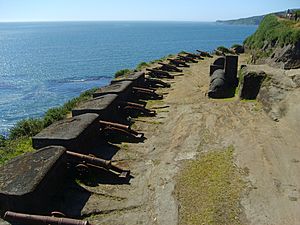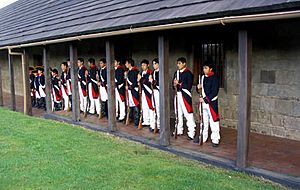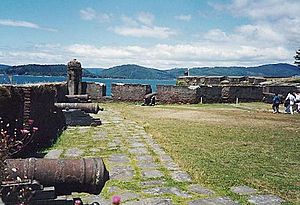Valdivian Fort System facts for kids

The Fort System of Valdivia is a group of old Spanish forts. They are located around Corral Bay, Valdivia, and the Cruces River in southern Chile. These forts were built to protect the city of Valdivia.
During the time Spain ruled Chile (1645–1820), this system was one of the largest groups of forts in the Americas. It was also a key place for Spanish ships to get supplies when they sailed through the Strait of Magellan.
Building the forts started in 1645. They were later improved after the Seven Years' War (1756–1763) by engineers Juan Garland and Manuel Olaguer Feliú. While it was a top fort system in Spanish America, other forts like those in Cartagena de Indias became more famous later on. Still, the Valdivia Fort System was the main coastal defense on the Pacific coast of Spanish America.
The forts saw action twice. First, in 1670, they faced a suspicious English group led by John Narborough. Later, in 1820, Chilean patriots led by Thomas Cochrane successfully captured the forts.
Contents
History of the Valdivia Forts
Before the Forts Were Built
First Spanish Settlement in Valdivia

The first European to visit the Valdivia River's mouth was Captain Juan Bautista Pastene in 1544. He claimed the area for the Spanish king, Carlos I. He named the river after the Governor of Chile, Pedro de Valdivia. Pedro de Valdivia later founded the city of Valdivia in 1552.
In 1598, Mapuche warriors led by Pelantaro attacked a Spanish group. This led to a big uprising among the Mapuche and Huilliche people in southern Chile. This conflict, called the Arauco War, lasted for over 250 years. Right away, it caused the "Destruction of the Seven Cities". Spanish cities like Valdivia were destroyed or left empty. Only Chillán and Concepción remained under Spanish control.
Most of Chile south of the Bío Bío River became free from Spanish rule. The empty city of Valdivia became an attractive spot for Spain's enemies. They could use it as a base in the middle of Spain's lands in Chile.
Dutch Interest in Valdivia
In 1600, local Huilliches joined a Dutch pirate named Baltazar de Cordes. They attacked the Spanish settlement of Castro in Chiloé. Spain worried that the Dutch might team up with the Mapuches. They feared the Dutch would build a stronghold in southern Chile.
Spain soon learned that the Dutch planned to settle at the ruins of Valdivia. Spain tried to get back control of Valdivia before the Dutch arrived. But it was hard to travel by land through the lands of the hostile Mapuches in the 1630s. The ruins of Valdivia, with its great natural harbor, remained a tempting target for Spain's enemies.
In 1643, the Dutch arrived at the ruins of Valdivia. They planned to use it as a base to attack the Spanish empire. After some problems with the Mapuche people there, the Dutch had to leave Valdivia.
Spain Returns to Valdivia
The Spanish Governor of Chile, Francisco López de Zúñiga, sent a ship to Valdivia in April 1644. They wanted to see if the Dutch were still there. By May, they found no Dutch. A Mapuche chief, Juan Manqueante, who was now friendly with Spain, said the Dutch planned to return.
So, Spain decided to take back Valdivia. A large Spanish fleet of twenty ships and 1,000 men came from Peru. This huge fleet was the biggest ever seen in the area. It arrived in Valdivia in February 1645 without any problems. The soldiers and their supplies landed safely.
The soldiers and workers began building a system of defensive forts. These forts became the Valdivia Fort System. It was the most important defense on the Pacific coast of South America. It is a great example of how forts were built in Spanish America.
Spain sent prisoners from all over Peru to build the forts. The Spanish settlements in Corral Bay became like prison colonies. To stop prisoners from escaping, Spain made deals with local Mapuches. They paid them to bring back any prisoners who ran away. Many of these prisoners were Afro-Peruvians. After serving their time, they often became soldiers or settlers. A survey in 1749 showed that many people of African descent lived in the area. In the 1600s, Spanish soldiers and local Mapuche people lived together in the forts. Some Mapuche were slaves. Because they lived so closely, many soldiers and prisoners learned some Mapuche language.
Building and keeping up the forts was very expensive for Spain. But it was seen as necessary to protect the southern entrance to Peru. Peru, along with Mexico, was Spain's main source of wealth. The money spent on defending Corral Bay proved useful in 1670. A fully armed English ship, led by John Narborough, arrived in the bay. This made the Spanish suspect an English attack was coming.
The area between Valdivia and the towns of Calbuco and Carelmapu remained independent Mapuche land. The Spanish could not easily travel there. This lack of knowledge led to many stories about the mythical City of the Caesars among the people of Valdivia.
Fort Improvements After the Seven Years' War
In the late 1700s, a big plan was made to fix and improve the forts. Engineers José Birt and Juan Garland were put in charge. The Valdivia defense system grew to have 17 strong points. These included watchtowers, castles, forts, and gun batteries. This system was very effective during the Spanish colonial period. It stopped enemy powers from attacking.
Spain and Great Britain were at war again in the 1770s because of the American Revolutionary War. In 1779, Spanish officials in Chile were warned that a British fleet was coming. It was led by Edward Hughes and planned to attack the Chilean coast. So, Peru sent money to the forts at Valparaíso and Valdivia. However, the expected attack never happened.
Independence Era and Capture

Military engineer Manuel Olaguer Feliú believed that the fort of Aguada del Inglés would be the landing spot for an enemy attack. He planned for this fort to hold most of the troops during a war.
Lord Cochrane's landing at Aguada del Inglés in 1820 proved Olaguer Feliú's plan was correct. Cochrane led Chilean patriots to capture the forts.
Forts, Batteries, and Outposts

The four largest forts in this system were in Corral Bay. They controlled the entrance to the Valdivia River, and thus Valdivia itself. Other forts were built to protect the city from attacks by land, mostly from local Huilliche people.
- Fuerte Aguada del Inglés
- Fuerte de San Carlos
- Batería del Barro
- Castillo de San Luís de Alba de Amargos
- Batería y Reducto de Chorocamayo
- Castillo de San Sebastián de la Cruz Fort (Corral Fort)
- San Sebastián de la Cruz Fort is in Corral, on the southern side of Corral Bay. It was the main base for the coastal defenses. It was built in 1645 by order of the viceroy Pedro Álvarez de Toledo y Leiva.
- Castillo de San Pedro de Alcántara (Isla Mancera Fort)
- The fort on Mancera Island is between Niebla and Corral. Because of its important location, it was suggested many times that the city of Valdivia should move to the small Mancera Island. But the people of Valdivia did not want to move.
- Batería del Carbonero
- Batería del Piojo
- Castillo de la Pura y Limpia Concepción de Monfort de Lemus (Niebla Fort)
- The fort in Niebla faces Corral Fort. It is at the northern entrance of the Valdivia River. The fort was being made bigger when work stopped in 1810. In 1834, when Chile controlled it, it was used as a storage place for the whole fort system.
- San Luis de Alba Fort
- San Luis de Alba Fort is on the banks of the Cruces River, north of Valdivia. It was built to protect the land route (Camino Real) to Valdivia where the road crossed the river.
- Los Torreones
- Los Torreones (Spanish for The Towers) are two towers. They were once built on the edge of Valdivia to protect the city from land attacks. The towers are now a local landmark. They are used as the logo for the local newspaper, El Diario Austral de Valdivia.
See also
 In Spanish: Sistema de fuertes de Valdivia para niños
In Spanish: Sistema de fuertes de Valdivia para niños



